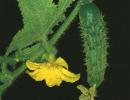
|
Cucumber
Scientific name:
Cucumis sativus
Order/Family:
Violales: Cucurbitaceae
Pests and Diseases:
Angular leaf spots
Anthracnose
Aphids
Damping-off diseases
Downy mildew
Epilachna beetles
Flea beetles
Fruit flies
Fruit rot
Fusarium wilt
Powdery mildew
Root-knot nematodes
Scab
Spider mites
Virus diseases
Whiteflies
Leafminer
|
Angular leaf spot (Pseudomonas syringae pv. lachrymans)
Spots on leaves are angular in shape and variable in size due to leaf veins that limit their enlargement. Initially, spots are water-soaked. In moist weather, bacteria ooze from the spots in tear-like droplets, which dry making the tissue white. Affected leaf dries and shrinks, and it may tear away from the healthy portion leaving irregular holes. Leaves approaching maturity are more susceptible than older leaves. Fruits may also be attacked. Fruit spots are small, nearly circular and superficial. The bacteria survive in association with seed. When infected cucumbers are used for seed extraction, the seed can be contaminated during fermentation process.
The bacteria can also survive in soil or infected crop debris. Drainage water can spread the bacteria in the soil. Angular leaf spot disease is favoured by wet conditions, frequently associated with rainfall and overhead irrigation. Optimum temperature for disease development is 23.9 to 27.8º C. The disease attacks gherkin, muskmelon, pumpkin, squash, vegetable marrow and watermelon.
- Use resistant varieties, if available.
- Use certified disease-free seed.
- Practice crop rotation. A crop rotation of 1 to 2 years is recommended.
- Avoid run-off water from nearby cucurbit fields and overhead irrigation.
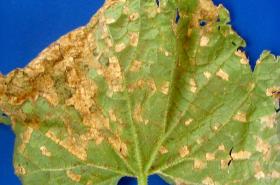
© A.A.Seif, icipe
Anthracnose (Colletotrichum orbiculare)
The fungus can attack all the above-ground plant parts. Cotyledons (seed leaves) of affected seedlings droop and wilt. Lesions (elongated spots) may form on stems of affected seedlings near the ground. Spots on leaves start as small yellowish areas that enlarge and turn brown. The affected tissue dries, breaks and the whole leaf dies. On vines, the spots are elongated and may kill the vines.
Symptoms are most noticeable on fruits. Spots on fruits are circular, black, and sunken. When wet, the centres of the spots become salmon coloured due to a mass of fungal spores. Affected fruits can be destroyed by secondary soft-rot organisms, which enter through broken rind. The fungus is seed-borne. It can survive in crop debris and in weeds belonging to the cucurbit family. Fungal development is promoted by wet conditions, high relative humidity and moderate temperatures (20 to 23.9º C). Its host range includes cucumber, gherkin, gourd, muskmelon, and watermelon. Cucurbit weeds can also be attacked.
- Use resistant varieties, if available.
- Use certified disease-free seeds.
- Practise crop rotation.
- Destroy volunteer cucurbits and weeds.

© Clemson University - USDA Cooperative Extension Slide Series, www.insectimages.org
Aphids (Aphis gossypii)
The cotton aphid (Aphis gossypii) is common on cucurbits, including cucumber. Colonies of green to blackish aphids are found on tender shoots, mainly on the lower leaf surface, where they suck sap. The growth of the attacked shoots is stunted and the leaves are curled and twisted. Aphids excrete honeydew, which leads to growth of sooty mould, and may attract fruit flies. Aphids, in particular winged aphids, transmit virus diseases (e.g. cucumber mosaic virus) when moving from plant to plant.
- Plant barrier crops.
- Apply sticky traps.
- Use botanicals (e.g. neem extracts).
- Use reflective mulch (e.g a polyethylene sheet covered with a thin layer of aluminium that is spread out on the growing bed at planting time). Covering the ground with a material like aluminium foil repels winged aphids, delay aphid colonisation and may delay virus infection.
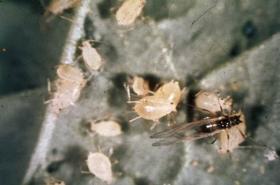
© Mississippi State University Archive, Mississippi State University, Bugwood.org
Damping-off disease
Damping-off diseases are caused by a complex of plant pathogens (disease inciting agents) including Alternaria spp., Fusarium spp., Pythium spp. and Rhizoctonia solani. These pathogenic fungi may cause rotting of seeds before emergence or death of seedlings after emergence. The most disposing factors are use of non-certified seeds and excessive watering of seed-beds or field plots.
- Always use certified disease-free seeds.
- Avoid overwatering of seed-beds or field plots where direct sowing is done.
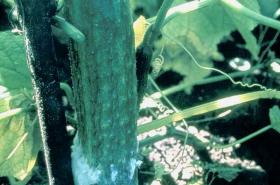
© Gerlach W. (Courtesy of EcoPort, www.ecoport.org)
Downy mildew (Pseudoperonospora cubensis)
Symptoms on leaves appear as small, pale-yellow areas on upper leaf surface. Under humid conditions, a purplish, grey whitish growth may be seen on the underside of the yellowish spots. Affected leaves curl, shrivel and die.
Most downy mildew fungi require cool weather for reproduction and development. This is not true of the cucurbit downy mildew fungus. Optimum temperature for infection is at 16 to 22º C. It can survive when temperatures are over 37.8º C. The most critical factor for infection is a film of moisture and / or long dew periods on leaves. Disease spread is primarily through wind and rain splash. The fungus attacks only members of the cucumber family, mostly those that are cultivated, although it can infect wild cucumber and a few other weed hosts.
- Use resistant varieties, if available.
- Leave wide spacing between plants.
- Avoid overlap cucumber plantings.
- Copper fungicides at 0.1% can provide control.
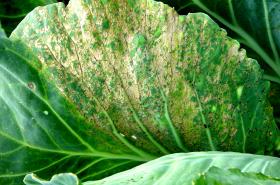
© A.M. Varela, icipe
Epilachna beetles (Epilachna chrysomelina)
Adults of this beetle, also known as the African melon ladybird, are 6-8 mm long, reddish in colour with a number of black spots on the wing cases. The larvae are 7-9 mm in length, soft and covered with dark coloured spines. Adults and larvae feed on leaves leaving a fine net of veins. Damaged leaves shrivel and dry up. Young plants can be entirely destroyed. Older plants can tolerate considerable leaf damage. This beetle is a vector of squash mosaic virus. Epilachna beetles attack all cucurbits.
- Spray neem extracts. Simple neem-based pesticides have given control of this pest in Togo. Thus, feeding by Epilachna beetles in squash and cucumber could be reduced significantly by weekly applications of aqueous neem kernel extracts at concentrations of 25, 50 and 100 g/l and neem oil applied with an ultra-low-volume (ULV) sprayer at 10 and 20 l/ha (Ostermann and Dreyer, 1995).
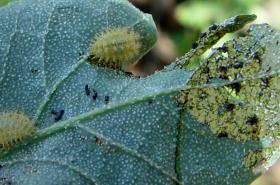
© A. M. Varela, icipe

Larvae of …

Epilachna …
Flea beetles (Podagrica spp)
They are 1.5 to 3 mm long with well-developed hind legs. They are named for their habit of jumping like fleas when disturbed. The colour of the adult beetles varies from black, brown, black and yellow striped or metallic blue-green depending on the species. Adult flea beetles chew small round holes (shot holes) in leaves, giving them a sieve like appearance. On rare occasions, they may feed directly on ripe fruit, just below the calyx. This damage is usually seen only in plants that show extreme foliar stress resulting from lack of water or powdery mildew. The larvae of flea beetles live in the soil and feed on roots, but the damage caused is not of economic importance. Adult flea beetles can be particularly damaging to young plants. Seedlings are most vulnerable to flea beetle feeding when stressed, particularly by inadequate moisture. Older plants can withstand considerable leaf perforation.
- Monitor the crop frequently, particularly during the first stages of the crop. Even a small flea beetle population can cause significant damage to a crop in the cotyledon or first-leaf stages.
- Provide good nutrition and favourable growing conditions. This helps to avoid plant stress from diseases and moisture, and helps plants survive flea-beetle attack.
- Weed in and around fields. This may help to eliminate flea beetle shelter and breeding grounds, reducing crop damage.
- Keep plant diversity in the farm. Living mulches or polycultures are known to reduce flea-beetle damage. Diversity in the farm supports populations of natural enemies.
- When necessary spray botanicals or other alternative products. Extracts of neem, rotenone, pyrethrin, sabadilla, garlic, onion and mint alone or in combination have been recommended for control of flea beetles. Insecticidal soap is reported to give partial control of flea beetles. However, sprays combining rotenone with insecticidal soap are considered very effective. Diatomaceous earth and rock powders have been observed to reduce flea-beetle populations but applications must be renewed regularly after rainfalls.
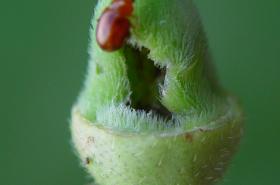
© A.M. Varela, icipe
Fruit flies (Bactrocera cucurbitae, Dacus spp and Ceratitis capitata)
Fruit flies are important pests of cucumber and other cucurbits.
Fruit flies are about 4-7mm long, they pierce the fruits and lay eggs in fruits. The fruit fly maggots feed inside the fruit causing sunken, discoloured patches, distortions and open cracks. These cracks serve as entry points for fungi and bacteria, causing fruit rot.
- Avoid continuous cultivation of cucumbers at the same place since this may lead to fruit fly outbreaks.
- Destroy all infested fruit.
- In small plots, wrap individual fruits or bag them with newspaper or paper bags to prevent fruit flies from laying eggs into fruits. Wrapping or bagging should be started shortly after fruit set.
- Spray with a pyrethrum solution in the evenings after the bees are mostly back in their hives (after 6 pm). There is a product commercially available called "Flower-DS", made of natural pyrethrum and acceptable in organic certified systems (see Hygrotech Company, contact-addresses below).
- Precautions: Be careful to spray late in the evening, follow the spraying instructions. Wear masks and skin protection.
All insect poisons are also poisonous to humans even if coming from natural sources.
- Frequency of spraying: start shortly after beginning of flowering, and repeat every 5 days or according to counts. - Frequent applications of neem can keep fruit fly attack to a minimum.
For more information on neem click here.

© A.M. Varela, icipe

Fruit fly …

Fruit fly …

Fruit fly …

Fruit fly …
Fruit rot
Fruit rots are of minor importance in Africa; they are primarily post-harvest problems during storage. In most African countries, cucumbers are sold fresh from farm, consumed and are hardly stored for long (exception could be supermarkets in urban areas where fruits are kept on shelves).
- Avoid injuries during harvesting
- Store fruits properly after harvest
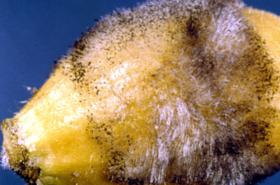
© Clemson University - USDA Cooperative Extension Slide Series, www.insectimages.org
Fusarium wilt (Fusarium oxysporium f.sp. cucumerinum)
In seedlings, the cotyledons lose their healthy look (luster) and wilt. This is followed by complete collapse of the plants. Older plants initially exhibit wilting and yellowing of leaves near the crown. Later individual vines and then the whole plant wilt and die. If the taproot and stem are split open, an orange-brown discolouration of the water conducting tissues will be seen. Fruits from affected vines are small with poor flavour and colour.
The fungus is a soil inhabitant. It enters the roots and grows in the water conducting tissues thereby blocking water movement. The fungus is also carried on the seeds and in soil adhering to farm implements. It can persist in soil for long periods. The disease is favoured by warm weather (optimum soil temperature for infection is about 27.8º C) and air humidity of more than 80% over a long period.
- Use resistant varieties, if available.
- Use certified disease-free seeds.
- Avoid spread of the fungus through contaminated farm implements and furrow irrigated water.
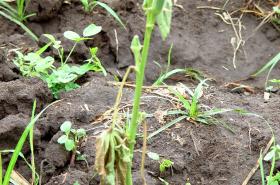
© A.M. Varela & A.A.Seif, icipe
Root-knot nematodes (Meloidogyne spp.)
Symptoms of infestation by root-knot nematodes are similar in all crops: wilting of plants and if infested plants are pulled from the soil the roots can be seen to be distorted, swollen and bearing knots. The infested roots eventually rot and affected plants die.
- Use resistant varieties, if available.
- Practise mixed cropping. Mixed cropping with African marigold (Tagetes spp.) minimises root-knot nematode damage. Intercrop with different mustards (e.g. Brassica juncea var. integrifolia or Brassica juncea var. juncea) on infested fields. As soon as mustards are flowering they are mulched and incorporated into the soil. While incorporated plant parts are decomposing in a moist soil, nematicidal compounds of this decomposing process kill nematodes. Two weeks after incorporating plant material into the soil a new crop can be planted or sown (phytotoxic effects are usual if the crop is planted before two weeks).
- Maintain high levels of organic matter in the soil (manure or compost).
- Use biofumigation where possible (biofumigation involves incorporation into the soil of crop residues of crucifers, resulting in high levels of organic matter).
- Use neem extracts.
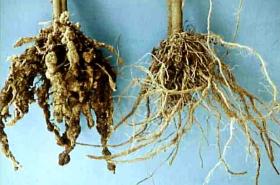
© A. M. Varela, icipe
Scab (Cladosporium cucumerinum)
It attacks all aboveground plant parts. Initial symptoms on leaves appear as light water-soaked or pale green spots. The spots are numerous and can appear on and between veins. Elongate spots may develop on petioles and stems. The spots later turn grey to white and become angular. The fine veinlets in the spots may be brown and are distinct against a white background. Dead leaf tissue cracks and breaks away until the whole leaf is ragged. Fruits can be attacked at all stages of growth. However, young fruits are most susceptible. Plant tissue near the spots may produce sap, initially watery but later becomes gummy to hard.
The fruit spots are cankerous and with time become darker, sunken until a pronounced cavity is formed. Under moist weather, a dark-green velvety layer of fungal growth appears on the cavities. The fungus survives in crop debris, soil and on seed. It is spread by insects, farm tools and wind. The disease is most severe at 100% relative humidity and at relatively cool temperatures (21-25ºC). Its host range includes cantaloupe, gherkin, muskmelon, pumpkin, squash and watermelon.
- Use resistant varieties, if available.
- Use certified disease-free seeds.
- Practise crop rotation with nonrelated crops.

© Courtesy EcoPort (http://www.ecoport.org): McKenzie E., Landcare Ltd., New Zealand
Red spider mites (Tetranychus spp.)
Red spider mites attack leaves of cucumber. Adults are about 0.6 mm long. Attacked leaves have a stippled appearance, turn yellowish to whitish and dry up. Often young plants are entirely destroyed. In older plants growth can be severely stunted and the fruit set considerable reduced. Spider mites can be a problem in dry and hot conditions. Plants under water stress (drought) are more likely to suffer damage by spider mites.
- Conserve natural enemies. Predatory mites and anthocorid bugs are important in natural control of mites.
- Avoid use of broad-spectrum pesticides. They may kill natural enemies and may lead to mite outbreaks.
- Provide good growing conditions for plants. Healthy plants are more likely to withstand mite attack. Adequate irrigation is particularly important. Apply mulch and incorporate organic matter into the soil to improve the water holding capacity and reduce evaporation.
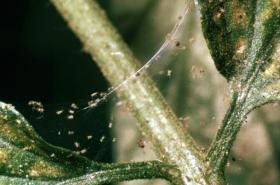
© Clemson University - USDA Cooperative Extension Slide Series, Bugwood.org

Spider mit…

Spider mit…
Mosaic Virus diseases
Cucumber mosaic virus
It is not seed transmitted except through seed of perennial wild cucumber (Echinocytis lobata) and chickweed (Stellaria media). It is mechanically transmitted and in nature it is spread by various species of aphids. It has a very extensive host range including such varied species as bananas, carrots, cowpeas, lupine, lilies, onions, passion fruit, potatoes and tomatoes.
Watermelon mosaic virus
This virus is mechanically transmitted and also spread by several species of aphids. It is not seed transmitted. Its host range is primarily restricted to cucurbits although one of its strains infects peas.
Squash mosaic virus
It is mechanically transmitted. It is transmitted through seeds of melons and squash. It is also transmitted by spotted, striped and banded cucumber beetles, which attack cucumbers in the Americas. The Epilachna beetle (Epilachna chrysomelina) a pest of cucumber in Africa, is also vector of squash mosaic virus. Its host range includes cucurbits, peas, coriander, and salad chervil.
- Use tolerant / resistant varieties if available.
- Remove infected plants (disinfect hands and tools with 70% alcohol after contact with infected plants).
- Do proper weeding.
- Control insect vectors. A sustainable approach of controlling aphids is important to prevent aphids reaching the crops and transmitting virus.
- In case of squash mosaic virus use certified disease-free seeds.

© A.A. Seif, icipe

Virus dise…

Virus dise…
Whiteflies (Bemisia tabaci)
They suck plant sap and excrete honeydew where moulds grow, which may affect plant growth and vigour. The tobacco whitefly is considered a major pest due to its ability to vector various virus diseases, which cause considerable damage to cucurbits.
- Conserve natural enemies. Parasitic wasps are important in natural control of whiteflies
- Use reflective mulches (see aphids). Reflective mulch repels whitefly adults in pumpkin, cucumber and zucchini squash, resulting in delayed and reduced attack by this pest with consequent reduction in damage as shown in experiments in USA. Whitefly density on pumpkins and cucumbers plants growing over reflective mulch was reduced 10- to 14-fold as compared to plants growing on bare soil. This was reflected in significantly higher yields in plants grown over reflective mulch than in those grown over unmulched soil. (UCANR, 2003; Summers & Stapleton 2002)
- Whenever necessary spray the crop with neem products. Neem-based pesticides are reported to inhibit growth and development of immature stages, and to reduce egg laying by adult whiteflies
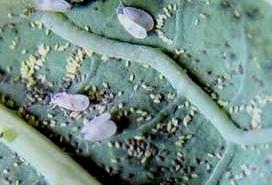
© A. M. Varela, icipe
| General Information and Agronomic Aspects | Information Source Links | |||
| Information on Pests | Contact Links | |||
| Information on Diseases |
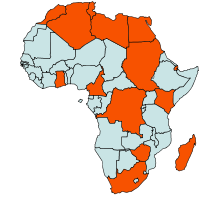 |
| Geographical Distribution of Cucumber in Africa |
Nutritive Value per 100 g of edible Portion
| Raw or Cooked Cucumber | Food Energy (Calories / %Daily Value*) |
Carbohydrates (g / %DV) |
Fat (g / %DV) |
Protein (g / %DV) |
Calcium (g / %DV) |
Phosphorus (mg / %DV) |
Iron (mg / %DV) |
Potassium (mg / %DV) |
Vitamin A (I.U) |
Vitamin C (I.U) |
Vitamin B 6 (I.U) |
Vitamin B 12 (I.U) |
Thiamine (mg / %DV) |
Riboflavin (mg / %DV) |
Ash (g / %DV) |
| Cucumber with Peel raw | 15.0 / 1% | 3.6 / 1% | 0.1 / 0% | 0.7 / 1% | 16.0 / 2% | 34.0 / 2% | 0.3 / 2% | 147 / 4% | 105 IU / 2% | 2.8 / 5% | 0.0 / 2% | 0.0 / 0% | 0.0 / 0% | 0.0 / 2% | 0.4 |
Cucumber varieties are categorised into four types on basis of fruit length:
- Long cucumbers: Fruit length over 30 cm. Examples: "Berlin RZ", "Bologna RZ", "Cumlande RZ", "Myrthos RZ", "Pluto RZ" "Virginia RZ")
- Midi cucumbers: Fruit length between 18 -24 cm Examples: "Media RZ"
- Mini cucumbers: Fruit length between 15 -19 cm. Examples: "Khassib RZ", "Gianco RZ"
- Cocktail cucumbers: Less than 15 cm. Examples: "Rania RZ"
Other varieties include:
- "Ashley" It takes about 65 days to maturity. Fruit colour is dark green. Fruit shape is long and spined. It has some resistance to downy mildew.
- "Danora F1 Hybrid". It is a long cucumber. It tales about 65 days to maturity. Fruit colour is green. Fruit is elongated. It has good resistance to powdery mildew and leaf spot.
- "Palomar". It takes about about 60 days to maturity. Fruit is dark green. Fruit is long and cylindrical. It has good tolerance to leaf diseases. It is good for pickling.
- "Poinsett". Poinsett is a variety with a very high yield potential, good disease and heat resistance.
- "Sarig". It is dark green in colour. Fruit length of 14-16 cm. It is very smooth and of high quality. It has a long shelf life. It is resistant to powdery mildew. It is suitable for green house production.
- "Super Marketer". Maturity period is 45 to 60 days. It grows well in hot climatic conditions. Its very high yielding about 16-32 t/ha. It is very popular in the local market.
- "Tempo" ("HA 78"). It is dark green in colour. The average fruit length is 30-35 cm. It has a good shelf life of up to 2 weeks. It is resistant to powdery mildew.
- "Toaz". It has a very vigorous growth. Fruit is dark green in colour. Fruit length is 16-18 cm. It is smooth and has a good shelf life, It is suitable for green house production.
- "Long Fellow"
- "Hybrid Victory"
- "Kande" (new variety produced in Tanzania)
Because varieties change all the time, please ask your local seed company to give information about the available varieties.
 |
| Cucumber |
| © A. Bruntse |
Some of the long slicing cultivars of cucumber are packed individually before marketing and cooled.
|
Fruit flies (Bactrocera cucurbitae, Dacus spp and Ceratitis capitata) Fruit flies are important pests of cucumber and other cucurbits. | 
Fruit fly maggots
Fruit fly maggots in watermelon fruit, the larvae are about 1cm long © A.M. Varela, icipe |
|
What to do:
|
- AIC, Nairobi (2003). Fruits and Vegetables Technical Handbook
- AVRDC International Cooperators' Factsheet on Cucurbits www.avrdc.org
- Beije, C.M., Kanyangia, S.T., Muriuki, S.J.N., Otieno, E.A., Seif, A.A., Whittle, A.M. (1984). Horticultural Crops Protection Handbook.National Horticultural Research Station, Thika KEN/75/028 and KEN/80/017/
- Blay, E., Cudjoe, A. R., Braun, M. (Editors) (2000). Handbook of crop protection recommendations in Ghana: An IPM approach. Vol 2; vegetables. Plant Protection & Regulatory Services Directorate (PPRSD) and the Integrated Crop Protection Project, German Development Cooperation (GTZ).
- Bohlen, E. (1973). Crop pest in Tanzania and their control. Federal Agency for Economic Cooperation (BFE). Veralgh Paul Parey. ISBN 3-489-64826-9
- CAB International (2005). Crop Protection Compendium, 2005 Edition. Wallingford, UK www.cabi.org
- East African Seed Co. Ltd. Africa's Best Grower's Guide www.easeed.com
- Ekesi, S., Billah, M.K. (Eds) (2006). A field guide to the management of economically important tephritid fruit flies in Africa. ICIPE. ISBN: 92-9064-179-7
- Kuepper, G. (2003). Flea Beetle: Organic Control Options. NCAT Agriculture Specialist. Published ATTRA Publication #CT114. National Sustainable Agriculture Information Service.
- Ministry of Agriculture and Rural Development (Kenya) (MoARD) & Japan International Cooperation Agency (JICA) (2000). Local and Export Vegetables Growing Manual. Reprinted by Agricultural Information Resource Centre, Nairobi, Kenya. 274 pp.
- Nutrition Data www.nutritiondata.com.
- Ostermann, H., Dreyer, M. (1995). Vegetables and grain legumes. In "The Neem tree Azadirachta indica A. Juss. and other meliaceous plants sources of unique natural products for integrated pest management, industry and other purposes". Edited by H. Schmutterer in collaboration with K. R. S. Ascher, M. B. Isman, M. Jacobson, C. M. Ketkar, W. Kraus, H. Rembolt, and R.C. Saxena. VCH. pp. 392-403. ISBN: 3-527-30054-6
- Sherf, A.F., Macnab, A.A.(1986). Vegetable Diseases and Their Control. 2nd. Edition. John Wiley & Sons Inc. USA. ISBN: 0-471-05860-2
- Summers, C.G. and Stapleton, J. J. (2002). Use of UV reflective mulch to delay the colonization and reduce the severity of Bemisia argentifolii (Homoptera: Aleyrodidae) infestations in cucurbits. Crop Protection. Volume 21. Pages 921-928. www.sciencedirect.com
- UCANR. UC helps pumpkin farmers produce pumpkins without pesticides. October 2003. www.ucanr.org
- Amiran Kenya Ltd. seeds@amirankenya.com
- East African Seed Company Ltd. www.easeed.com
- For information on small scale farming techniques, seeds, equipment and insecticides(e.g. pyrethrum solution).
HYGROTECH EAST AFRICA, LTD
Region :KENYA / TANZANIA - Location: NAIROBI
Address :P.O.Box 41446, Nairobi, Tigoni Centre, Limuru Road, KENYA
Phone :+254 (0) 20 205 3916-8
Fax :+254 (0) 20 205 3921
E-Mail: andrew@hygrotech.co.ke
- Simlaw Seeds Co. Ltd. simlaw@kenyaweb.com

 Back
Back
